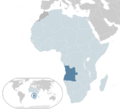Angola Energy Situation
Capital:
Luanda
Region:
Coordinates:
8.8333° S, 13.3333° E
Total Area (km²): It includes a country's total area, including areas under inland bodies of water and some coastal waterways.
1,246,700
Population: It is based on the de facto definition of population, which counts all residents regardless of legal status or citizenship--except for refugees not permanently settled in the country of asylum, who are generally considered part of the population of their country of origin.
35,588,987 (2022)
Rural Population (% of total population): It refers to people living in rural areas as defined by national statistical offices. It is calculated as the difference between total population and urban population.
32 (2022)
GDP (current US$): It is the sum of gross value added by all resident producers in the economy plus any product taxes and minus any subsidies not included in the value of the products. It is calculated without making deductions for depreciation of fabricated assets or for depletion and degradation of natural resources.
106,782,770,715 (2022)
GDP Per Capita (current US$): It is gross domestic product divided by midyear population
3,000.44 (2022)
Access to Electricity (% of population): It is the percentage of population with access to electricity.
48.22 (2021)
Energy Imports Net (% of energy use): It is estimated as energy use less production, both measured in oil equivalents. A negative value indicates that the country is a net exporter. Energy use refers to use of primary energy before transformation to other end-use fuels, which is equal to indigenous production plus imports and stock changes, minus exports and fuels supplied to ships and aircraft engaged in international transport.
-541.00 (2014)
Fossil Fuel Energy Consumption (% of total): It comprises coal, oil, petroleum, and natural gas products.
48.31 (2014)
"Africa" is not in the list (Sub-Saharan Africa) of allowed values for the "CES Country Region Africa" property.
Introduction
Three decades of civil war has destroyed much of the infrastructures of Angola and a large part of the population is also displaced. Therefore, Angola also ranks low among African countries in many human development indicators.Only a small percentage of Angola's population has access to electricity. The State-owned generation company has about 900 MW of installed capacity where 60% of the installed capacity is hydro while rest is primarily diesel-fired thermal.[1]





















